Solid state battery research: semi-solid state battery has come out, is all-solid state battery still far away?
In recent years, the new energy vehicle market has been booming, and the penetration of new energy vehicles has sustained steady growth. From January to April 2023, the production and sales of new energy vehicles in China reached 2.291 million units and 2.222 million units, respectively, both jumping by 42.8% on a like-on-like basis, with a market share of 27%. With rising sales, new energy vehicles demand ever more power batteries. It is estimated that the global electric vehicle battery usage is expected to reach approximately 749GWh in 2023.
In the era when the installation of power batteries in vehicles approaches TWh, suppliers step up production of solid-state batteries with higher energy density, driven by favorable policies and market demand.
In China, the "New Energy Vehicle Industry Development Plan (2021-2035)" issued by the General Office of the State Council on November 2, 2020 specifies that the R&D and industrialization of solid-state power battery technologies should be accelerated, and the R&D of solid-state batteries is raised to the national level for the first time. China's power battery industrialization goal is that in 2025, the energy density of liquid battery cells will reach 350Wh/kg; in 2030, the energy density of solid-liquid hybrid battery cells will be 400Wh/kg; in 2035, the energy density of quasi/all-solid-state battery cells will reach 500Wh/kg.
Meanwhile, Japan, South Korea, Europe and the US have also introduced incentive policies to develop solid-state batteries. For example, the US released the National Blueprint for Lithium Batteries 2021-2030 in 2021; Europe issued the Battery 2030+ and the Battery Innovation Roadmap 2030; most Japanese and Korean companies team up to develop, and automakers, scientific research institutions, and battery and materials companies divide labor clearly and are keen on cooperative development of solid-state battery technology.
1. Compared with the current mainstream liquid batteries, solid-state batteries have begun to get a foothold by virtue of bringing quite a few benefits.
Compared with liquid lithium batteries, solid-state batteries use solid electrodes and solid state electrolytes. In theory their energy density can reach up to 400-500Wh/kg, which is 2 to 3 times that of liquid lithium batteries. Solid-state batteries offers the benefits of cruising range increase, much lower thermal runaway risk, shorter charging time, longer cycle life, and smaller size. It is particularly worth noting that lithium metal anodes can increase the energy density of batteries by more than 70%.
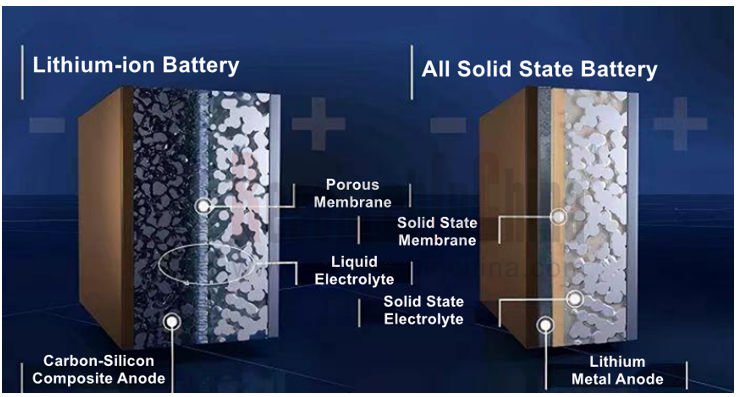
On this basis, ever more companies double down on R&D and production of solid-state batteries. Among power battery companies, CATL, Gotion Hi-Tech, Ganfeng Lithium, EVE Energy and Sunwoda are working hard on layout of solid-state battery technology. Yet for the moment the volume production of semi-solid state batteries will start earlier.
2. With increasing energy density of batteries, semi-solid state battery prototypes begin to be used in vehicles.
As a transitional route, semi-solid state batteries can improve safety performance, because the reduction of electrolytes lowers the thermal runaway risk caused by external heating and shock and internal short circuits. The electrolyte content in semi-solid state batteries is about 10% or below (the electrolyte mass of conventional lithium batteries makes up about 20%), and the soft package + laminated packaging process is used commonly. In terms of system, semi-solid state batteries can follow the 811 system, or adapt to more radical chemical systems such as the group 9, offering improvements in both energy density and comprehensive cost.
On January 22, 2022, E70, the demonstration operating car carrying the Dongfeng-Ganfeng high specific energy solid-state battery jointly developed by Dongfeng Motor and Ganfeng Lithium, made its world debut in Xinyu City, Jiangxi Province. Since then, the trial use of solid-state battery prototypes in vehicles has been kicked off.
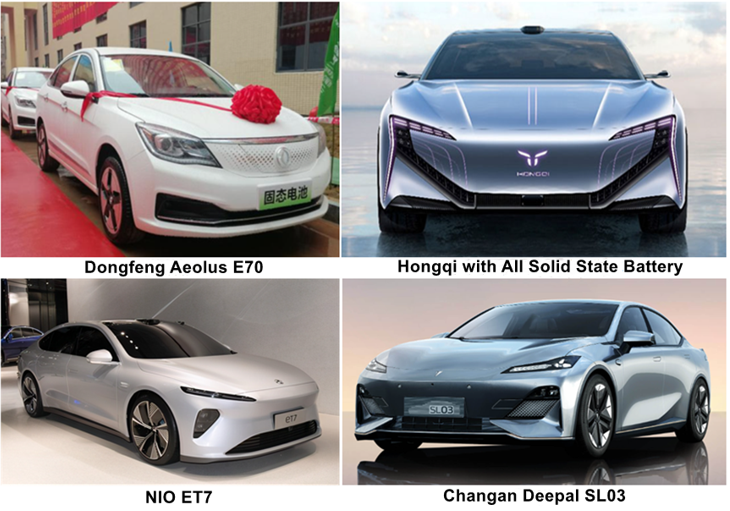
At present, companies that can mass-produce semi-solid state batteries include Beijing WeLion New Energy Technology, QingTao (KunShan) Energy Development, Talent New Energy, ProLogium Technology, Ganfeng Lithium, Gotion Hi-Tech, and EVE Energy.
Among them, WeLion New Energy's first semi-solid state battery was rolled off the production line in November 2022, with energy density of 360Wh/kg; Talent New Energy put into production China’s first semi-solid state battery production line in October 2022, a facility expected to come into full operation in July 2023, with planned annual capacity up to 10GWh during 2023-2024 and 26GWh during 2024-2026; in April 2023, QingTao (KunShan) Energy Development's first production line with designed capacity of 1GWh became operational, with the first batch of semi-solid state batteries rolled off the line in the Pidu Factory.
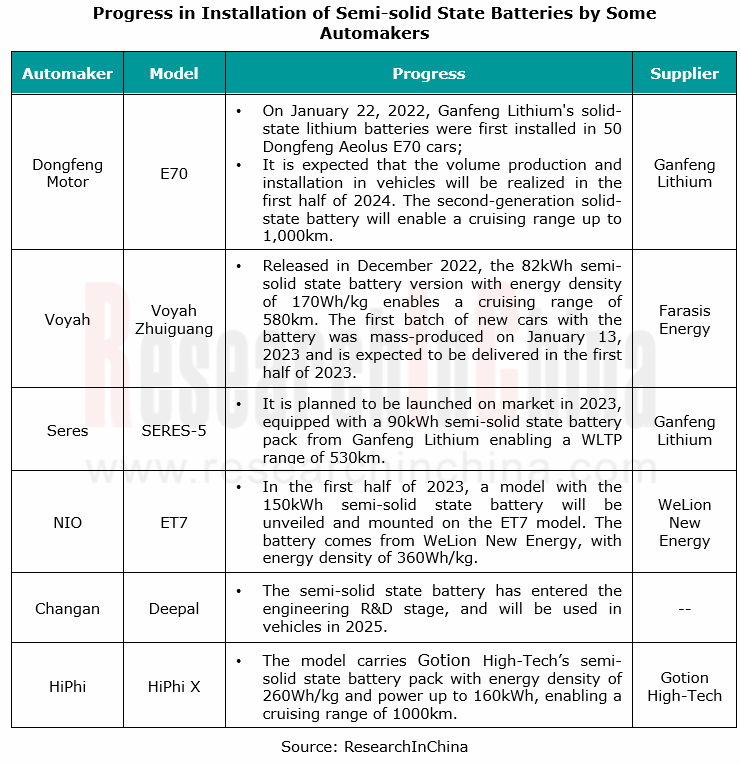
3. All-solid-state batteries are expected to be mass-produced around 2024.
The mass production of all-solid-state batteries are expected to start around 2024. Major companies include Nissan, Samsung SDI, and Montavista Energy Technologies.
From the solid-state battery production line layout, it can be seen that foreign companies start earlier, for example:
Solid Power brought into operation a continuous process pilot production line in Louisville, Colorado in 2019; produced 320Wh/kg 20Ah lithium metal batteries in 2020; announced the addition of a second Denver-area production facility in Thornton, Colorado in 2021; on June 6, 2022, announced that it has completed the installation of its pilot production line designed to produce electric vehicle batteries, aiming to accelerate the production of automotive solid-state batteries. In January 2023, BMW and Solid Power started the next-stage joint R&D of all-solid-state batteries. Solid Power licenses cell design and manufacturing processes to the BMW Group to help it build a pilot line in Munich. The first prototype vehicle will be launched before 2025, and the all-solid-state batteries will be produced in quantities in 2030.
In March 2022, Samsung SDI announced that it started the launch of the pilot line (S-line) for manufacturing solid-state batteries at SDI R&D Center located in Yeongtong-gu, Suwon-si, Gyeonggi-do. The facility will start trial production in 2023 and achieve large-scale production in 2027.
Among foreign OEMs, in 2024 Nissan will start a pilot plant in Yokohama, Japan and set up an all-solid-state battery production line; it will produce all-solid-state batteries in 2025 and see them installed into vehicles in 2028. Toyota will produce all-solid-state batteries on small scale and first use them in HEV models before 2025; it will achieve continuous and stable production of all-solid-state batteries before 2030.
Most Chinese companies take a production route gradually from semi-solid to all-solid state batteries. The companies that quickly realize the production of all-solid-state batteries are led by GTC-Power, Beijing WeLion New Energy Technology, QingTao (KunShan) Energy Development, ProLogium Technology, Gotion Hi-Tech and EVE Energy.
For example, EVE Energy will iterate its all-solid-state battery technology in three phases, and will concentrate on the oxide, sulfide and halide R&D routes. The company plans to complete the R&D of the all-solid-state battery technology 1.0 in 2024, with energy density of 350Wh/kg and cycle life more than 300 times; iterate its all-solid-state battery technology to 3.0 in 2028, which features high safety, high flexibility and high temperature resistance to meet the requirements of power batteries, with energy density increased to 550Wh/kg and cycle life up to over 1,000 times.
On December 21, 2021, the Japanese laboratory of GTC-Power successfully developed a 1.5Ah all-solid-state lithium battery sample, which heralds GTC-Power’s entry into the fast lane in R&D of all-solid-state lithium batteries. Its all-solid-state power battery has passed the acupuncture and 350°C thermal runaway tests, with energy density greater than 400Wh/kg and cycle life more than 1,200 times, and it can still work at -40°C-150°C.
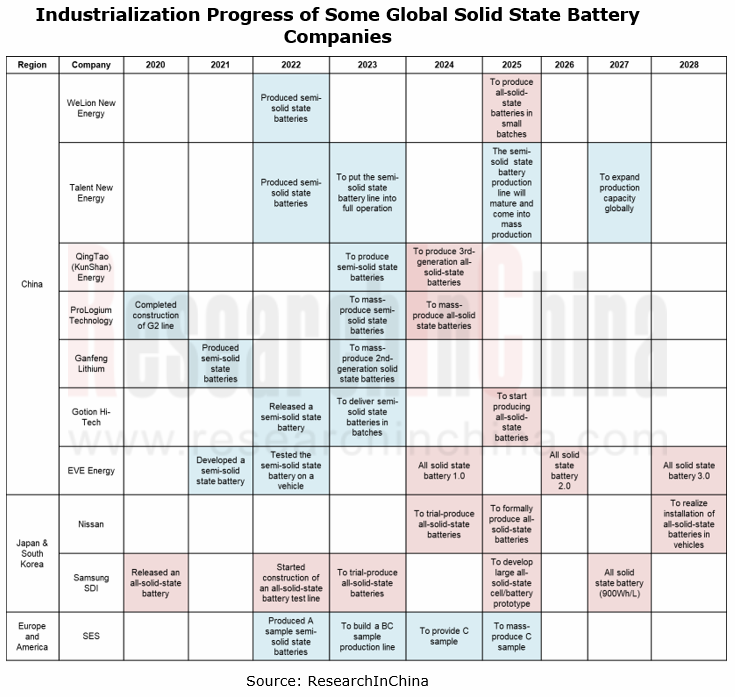
4. What are the constraints on the industrialization of solid-state batteries?
At present, solid-state batteries still have such problems as high interfacial impedance between the solid-state electrolyte and the electrode, and relatively low bulk ionic conductivity of the solid-state electrolyte. The solutions to the high interfacial impedance and low conductivity are the key to the industrialization of solid-state lithium batteries.
Solutions:
① Ultrathin electrolyte is one of the effective ways to reduce interfacial impedance in the industry. For example, Talent New Energy’s research institute and its Chongqing manufacturing base have developed electrolyte ultra-thin film preparation technology and interface softening technology using innovative processes and new customized equipment, and its process system compatible with the existing liquid batteries can go into production quickly.
② The solid-state battery interface softening technology is also an effective solution to lower interfacial impedance. For example, the existing halide-based all-solid-state thin-film pouch battery technology of EVE Energy can adapt to special high temperature and bending conditions, and allows for stable discharging in the high temperature zone of 150°C by combining high nickel anodes. The softening technology enables normal battery charge and discharge even in the condition of 120 ° bending.
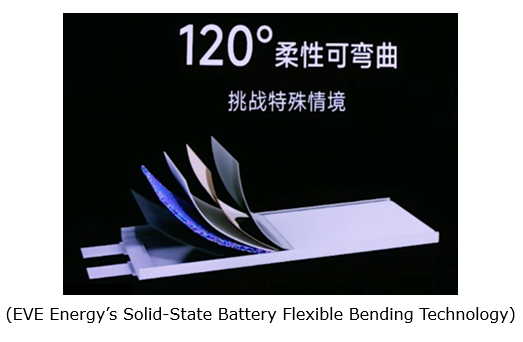
③ Among the three major electrolyte systems (polymer, oxide and sulfide), the sulfides are soft and flexible and feature the highest ionic conductivity, up to the level of liquid electrolyte (10-2 S/cm), breaking the conductivity bottleneck of solid state electrolytes. Yet sulfides with high resistance are easy to have side reactions with air, water, etc., posing many process challenges. Typical companies taking the sulfide route include GTC-Power, Enpower Greentech, CATL, Toyota, Honda, Samsung, and Solid Power.
Nevertheless, oxide solid state electrolyte is currently at the forefront in terms of industrial application and production nodes. With both electrical conductivity and stability, oxides are relatively easy to spawn and thus develop rapidly. Typical companies that choose the oxide system include WeLion New Energy, QingTao (KunShan) Energy, ProLogium Technology, Gotion Hi-Tech, Farasis Energy and Ganfeng Lithium.
In addition to the abovementioned, the varying production processes and the purchase of new equipment have also slowed down the production to a certain extent. At present, semi-solid state batteries can be basically compatible with liquid battery production lines, at almost flat cost. Amid a gradual transition to the production of all-solid-state batteries, because of very different processes and production procedures, a large number of new process equipment like isostatic pressing equipment need to be purchased. Isostatic pressing equipment is difficult to produce, debug and use, and also needs a lot of know-hows and experience to attain the efficiency and yield of lithium battery rolling and hot pressing processes, which undoubtedly places some pressure on the industrialization of solid-state batteries.
Finally, relevant manufacturers also need to continuously optimize their production line equipment and production processes to improve the yield of battery cell packaging and increase sales. This is also one of the key factors to realize the virtuous circle of the solid-state battery industry.
OEMs and Tier 1 Suppliers' Cost Reduction and Efficiency Enhancement Strategy Analysis Report, 2025
ResearchInChina released the "OEMs and Tier 1 Suppliers' Cost Reduction and Efficiency Enhancement Strategy Analysis Report, 2025", summarizing hundreds of cost reduction strategies to provide referen...
Automotive Fixed Panoramic Sunroof and Smart Roof Research Report, 2025
With the intelligent application of car roofs as the core, this report systematically sorts out a series of new products such as fixed panoramic sunroof/openable sunroof, ceiling screen, roof ambient ...
Automotive-Grade Power Semiconductor and Module (SiC, GaN) Industry Research Report, 2025
SiC/GaN Research: Sales volume of 800V+ architecture-based vehicles will increase more than 10 times, and hybrid carbon (SiC+IGBT) power modules are rapidly being deployed in vehicles.
Sales volume o...
Cockpit Agent Engineering Research Report, 2025
Cockpit Agent Engineering Research: Breakthrough from Digital AI to Physical AI
Cockpit Agent Engineering Research Report, 2025 starts with the status quo of cockpit agents, summarizes the technical ...
Prospective Study on L3 Intelligent Driving Technology of OEMs and Tier 1 Suppliers, 2025
L3 Research: The Window of Opportunity Has Arrived - Eight Trends in L3 Layout of OEMs and Tier 1 Suppliers
Through in-depth research on 15 OEMs (including 8 Chinese and 7 foreign OEMs) and 9 Tier 1 ...
China Commercial Vehicle IoV and Intelligent Cockpit Industry Research Report 2025
Commercial Vehicle IoV and Cockpit Research: The Third Wave of Passenger Car/Commercial Vehicle Technology Integration Arrives, and T-Box Integrates e-Call and 15.6-inch for Vehicles
I. The third wav...
Intelligent Vehicle Electronic and Electrical Architecture (EEA) and Technology Supply Chain Construction Strategy Research Report, 2025
E/E Architecture Research: 24 OEMs Deploy Innovative Products from Platform Architectures to Technical Selling Points
According to statistics from ResearchInChina, 802,000 passenger cars with domain...
Research Report on Intelligent Vehicle Cross-Domain Integration Strategies and Innovative Function Scenarios, 2025
Cross-Domain Integration Strategy Research: Automakers' Competition Extends to Cross-Domain Innovative Function Scenarios such as Cockpit-Driving, Powertrain, and Chassis
Cross-domain integration of ...
China Autonomous Driving Data Closed Loop Research Report, 2025
Data Closed-Loop Research: Synthetic Data Accounts for Over 50%, Full-process Automated Toolchain Gradually Implemented
Key Points:From 2023 to 2025, the proportion of synthetic data increased from 2...
Automotive Glass and Smart Glass Research Report, 2025
Automotive Glass Report: Dimmable Glass Offers Active Mode, Penetration Rate Expected to Reach 10% by 2030
ResearchInChina releases the Automotive Glass and Smart Glass Research Report, 2025. This r...
Passenger Car Brake-by-Wire (BBW) Research Report, 2025
Brake-by-Wire: EHB to Be Installed in 12 Million Vehicles in 2025
1. EHB Have Been Installed in over 10 Million Vehicles, A Figure to Hit 12 Million in 2025.
In 2024, the brake-by-wire, Electro-Hydr...
Autonomous Driving Domain Controller and Central Computing Unit (CCU) Industry Report, 2025
Research on Autonomous Driving Domain Controllers: Monthly Penetration Rate Exceeded 30% for the First Time, and 700T+ Ultrahigh-compute Domain Controller Products Are Rapidly Installed in Vehicles
L...
China Automotive Lighting and Ambient Lighting System Research Report, 2025
Automotive Lighting System Research: In 2025H1, Autonomous Driving System (ADS) Marker Lamps Saw an 11-Fold Year-on-Year Growth and the Installation Rate of Automotive LED Lighting Approached 90...
Ecological Domain and Automotive Hardware Expansion Research Report, 2025
ResearchInChina has released the Ecological Domain and Automotive Hardware Expansion Research Report, 2025, which delves into the application of various automotive extended hardware, supplier ecologic...
Automotive Seating Innovation Technology Trend Research Report, 2025
Automotive Seating Research: With Popularization of Comfort Functions, How to Properly "Stack Functions" for Seating?
This report studies the status quo of seating technologies and functions in aspe...
Research Report on Chinese Suppliers’ Overseas Layout of Intelligent Driving, 2025
Research on Overseas Layout of Intelligent Driving: There Are Multiple Challenges in Overseas Layout, and Light-Asset Cooperation with Foreign Suppliers Emerges as the Optimal Solution at Present
20...
High-Voltage Power Supply in New Energy Vehicle (BMS, BDU, Relay, Integrated Battery Box) Research Report, 2025
The high-voltage power supply system is a core component of new energy vehicles. The battery pack serves as the central energy source, with the capacity of power battery affecting the vehicle's range,...
Automotive Radio Frequency System-on-Chip (RF SoC) and Module Research Report, 2025
Automotive RF SoC Research: The Pace of Introducing "Nerve Endings" such as UWB, NTN Satellite Communication, NearLink, and WIFI into Intelligent Vehicles Quickens
RF SoC (Radio Frequency Syst...